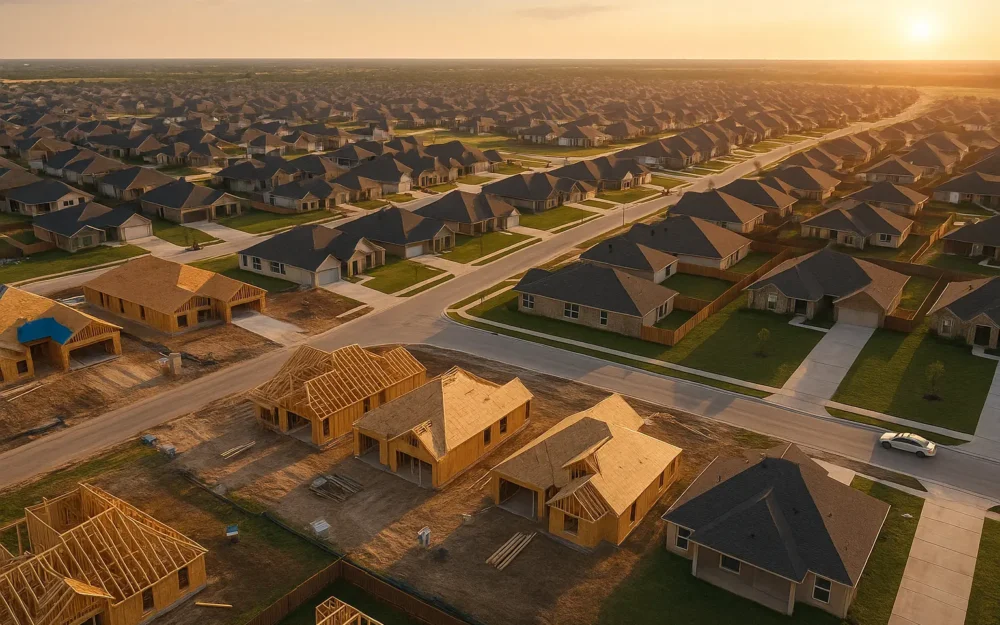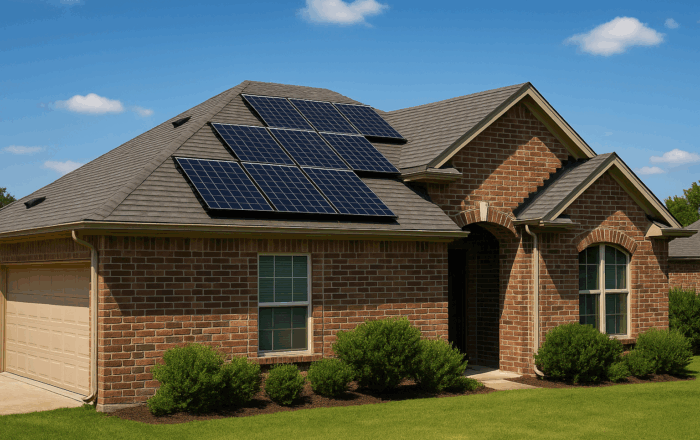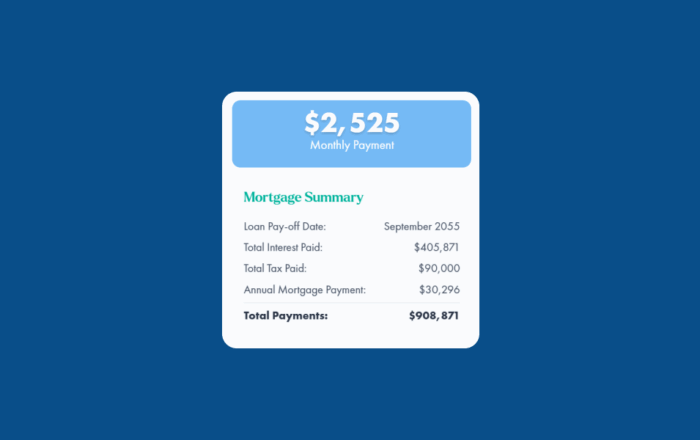Home Improvement Living in Texas
How Many Solar Panels Do You Need in Texas?
4 minute readHow to calculate the number of solar panels you need to power your Texas home
Home > BKV Energy Blog > All Posts > Top 10 Fastest Growing Cities in Texas
Texas continues to attract new residents at record levels.
5 minute read • Last update October 2025

While many small towns or suburbs may grow rapidly in percentage terms, the real stress on infrastructure, housing, and utility services comes where large cities are absorbing hundreds of thousands of new residents.
Texas has been leading the nation in population growth for over a decade, and 2024 was no exception. From powerhouse metros to rapidly expanding suburbs, people are flocking to the Lone Star State for jobs, affordable living, and quality of life.
Here’s a closer look at the top 10 fastest-growing cities in Texas, based on population changes between 2023 and 2024.
| Rank | City | Population 2023 | Population 2024 | Population Change | % Change |
|---|---|---|---|---|---|
| 1 | Houston | 2,346,908 | 2,390,125 | +43,217 | 1.8% |
| 2 | San Antonio | 1,502,711 | 1,526,656 | +23,945 | 1.6% |
| 3 | Fort Worth | 984,664 | 1,008,106 | +23,442 | 2.4% |
| 4 | Dallas | 1,306,350 | 1,324,928 | +18,578 | 1.4% |
| 5 | Frisco | 232,204 | 244,127 | +11,923 | 5.1% |
| 6 | McKinney | 209,949 | 218,384 | +8,435 | 4.0% |
| 7 | Georgetown | 96,948 | 104,638 | +7,690 | 7.9% |
| 8 | Austin | 978,908 | 986,331 | +7,423 | 0.8% |
| 9 | Leander | 82,836 | 89,236 | +6,400 | 7.7% |
| 10 | Killeen | 157,507 | 163,445 | +5,938 | 3.8% |
The table makes clear that Texas’s biggest cities and suburbs aren’t just growing, they’re reshaping the state’s economic and cultural landscape. Houston, San Antonio, and Fort Worth are absorbing the largest number of new residents, while fast-growing suburbs like Frisco, Georgetown, and Leander are punching far above their weight in percentage growth.
To understand what’s driving these changes, let’s take a closer look at each city and the forces behind its surge.
Houston leads the state by a wide margin, adding more than 43,000 new residents in a single year. Its diverse economy is one of the many reasons people are moving to Houston.
Anchored by energy, healthcare, shipping, and international trade, Houston’s economy continues to pull people in from across the country and around the world. Suburbs like Katy, The Woodlands, and Sugar Land remain hot spots for new housing development, and Houston’s cultural diversity makes it one of the most international cities in America.
San Antonio ranks second, growing by nearly 24,000 residents between 2023 and 2024. The city offers a lower cost of living than Austin or Houston, which has made it particularly attractive for families and retirees.
Anchored by its strong military presence, a booming cybersecurity sector, and an expanding healthcare industry, San Antonio combines economic strength with affordability. Suburbs such as New Braunfels and Boerne are seeing their own surge as spillover growth accelerates.
Fort Worth added more than 23,000 new residents in just one year, officially surpassing the one-million mark. Long overshadowed by Dallas, Fort Worth is now carving out its own identity as a cultural and economic powerhouse within North Texas.
The city offers more affordable housing than Dallas proper, and its family-friendly environment is drawing people from across the state and beyond. Rapid growth is driving demand for new schools, transit improvements, and expanded housing developments.
Dallas gained nearly 19,000 residents between 2023 and 2024, cementing its role as a key driver of Texas’s economy. Known for its strong finance, healthcare, and tech sectors, Dallas continues to attract both businesses and talent.
While surrounding suburbs like Plano and Frisco absorb much of the region’s expansion, Dallas remains a hub for employment, entertainment, and cultural amenities. Continued corporate relocations ensure its steady long-term growth.
Frisco remains one of the fastest-growing suburban cities in the nation, adding nearly 12,000 residents in a single year. Known for master-planned communities, excellent schools, and high-end amenities, Frisco has become a top destination for families.
Its location just north of Dallas makes it attractive for commuting professionals, while its reputation for safe neighborhoods and thriving retail centers cements its appeal.
McKinney continues its rise, adding 8,400 new residents in one year. Its historic downtown, strong school system, and family-friendly amenities have made it one of the most desirable cities in Collin County.
McKinney strikes a balance between suburban living and a community-oriented atmosphere, while still providing easy access to jobs in Plano, Dallas, and beyond.
Georgetown’s population grew by nearly 7,700 people, a jump of 7.9%—the highest percentage growth among Texas’s larger cities.
Located just north of Austin, Georgetown is increasingly popular with families and retirees looking for affordability and small-town charm while staying connected to the Austin job market. Its historic town square and rapid development have made it one of Texas’s most talked-about growth stories.
Austin added about 7,400 new residents between 2023 and 2024. While that growth is slower than in past decades, the city remains a magnet for tech firms and creative talent. Startups and global companies alike continue to expand in Austin, but affordability has become a major concern.
Rising home prices and cost of living are pushing many newcomers into nearby suburbs like Georgetown, Leander, and Cedar Park, shifting the region’s growth outward.
Leander added 6,400 residents in one year, growing by 7.7%. Once a small bedroom community, Leander has transformed into one of the fastest-growing suburbs in Texas. Families are drawn to its affordability, strong schools, and access to Austin’s job market. New housing developments continue to sprawl outward, making Leander a growth engine for the Austin metro area.
Killeen rounds out the top 10 with nearly 6,000 new residents added between 2023 and 2024. Anchored by Fort Cavazos (formerly Fort Hood), the city’s military presence drives both economic stability and steady population increases. Affordable housing and a strong sense of community make Killeen attractive to military families and civilians alike.
Texas continues to experience one of the strongest population booms in the country. Job opportunities, affordability, and the absence of a state income tax make the state highly attractive to both businesses and individuals.
Migration from high-cost states like California and New York continues to fuel demand for housing and services in Texas.
These drivers underpin not just the growth of the largest metros but also the rapid rise of suburban communities.
Several key factors are influencing why so many Americans are choosing Texas. A lower cost of living compared to other major states allows families to stretch their budgets further. No state income tax and a pro-business environment add to the financial incentives.
Robust job markets spanning energy, technology, healthcare, and logistics provide opportunities across industries. On top of that, Texas’s warm climate and quality of life make it appealing for both young professionals and retirees.
But as more people arrive, Texas faces growing pains that are becoming harder to ignore.
Rapid growth also creates significant challenges. Infrastructure is strained, with traffic congestion and limited public transit options in most metros. Housing affordability is an increasing concern, particularly in Austin and Houston.
Environmental issues such as rising water and energy demand, as well as urban sprawl, are also pressing challenges policymakers must address.
Still, even with these hurdles, Texas’s long-term trajectory continues to point upward.
Looking ahead, emerging hotspots like Leander, Katy, Prosper, and Cedar Park are expected to continue their rapid expansion.
The rise of industries such as clean energy, artificial intelligence, and biotechnology may further shape migration and development patterns. With its strong economy, central U.S. location, and business-friendly policies, Texas is positioned to remain a top relocation destination for decades to come.
We may be partial, but being part of Texas’s growth story is exciting. As cities across the state welcome new residents and communities expand, one thing everyone needs is reliable and affordable electricity.
At BKV Energy, we’re proud to power this growth by offering Texans simple, transparent plans with no hidden fees. Our coverage reaches more than 90% of households across the state, and every plan comes with straightforward contracts and a risk-free 30-day cancellation period.
Whether you are new to Texas or a lifelong resident, BKV Energy makes it easy to find an electricity plan you can trust while helping you enjoy everything the Lone Star State has to offer. Enter your zip code below to get started!
Graham Lumley, Digital Marketing Manager at BKV Energy, leads digital and traditional marketing strategies, focusing on educating Texans about the state's deregulated energy market. With over 8 years of marketing experience, he creates content to help consumers understand and save on their energy bills, bringing a fresh and dynamic approach to the industry.

Home Improvement Living in Texas
How to calculate the number of solar panels you need to power your Texas home

Estimate your mortgage payments with BKV Energy's free mortgage calculator
Get $50 off your electric bill!
Use code BKVEJOINUS50
Enter your zip code to shop BKV Energy's affordable, fixed-rate Texas electricity plans. Use the promo code for $50 off your electric bill.